Energy use and the environment
Saving energy reduces the overall demand for the resources needed to produce energy.
 While saving money is the initiator of
energy-saving practices in the home, protecting the environment is an important
positive by-product. Why should we be concerned about household energy use?
While saving money is the initiator of
energy-saving practices in the home, protecting the environment is an important
positive by-product. Why should we be concerned about household energy use?
- 113 million residences account for approximately 22 percent of the energy used in the U.S.
- The average U.S. home heating and cooling system emits more than one-half billion tons of carbon dioxide, which contributes to air pollution and global warming.
- Electricity generated from fossil fuels for one home puts more carbon dioxide (CO2) into the air than two average cars.
- The average family spends more than $2,000/year on utility bills and wastes 30-50 percent of the energy it purchases.
Homeowners can save 10 to 50 percent on utility bills and reduce air pollution by adopting a few inexpensive energy efficient practices.
Energy assessments or audits show what areas of the home use the most energy. They can offer suggestions on ways to cut energy costs through efficiency measures and/or updated equipment. Free tools and calculators are available online. Utility companies offer home energy audits for a small fee. You should assess your home energy use using a whole house approach viewing it as one system with interdependent parts.On average, heating and cooling uses more energy than any other system in the home – approximately 54 percent (see graph No.1). Three key strategies to improved energy efficiency:
- Add insulation
Thirty-one percent of a home’s heat loss is through floors, walls and ceilings (see graph No.2). Insulation prevents the transfer of heat through these surfaces. Insulation has a “R-value” number that indicates how resistant the insulation is to air passing through it. The higher the R-value, the better it will prevent warm air from passing through it. The amount of insulation a house needs depends on climate in your area, building design, and heating and cooling costs in the area. Insulation with an R-value of R-36” is recommended in Michigan. - Improve
windows
Windows account for 10 to 25 percent of home heating bill due to leaks. Replacing old windows with energy-efficient ones, adding storm windows or covering windows with plastic can reduce heat loss by 25 to 50 percent. Windows have a “U-factor” to determine energy efficiency: The lower the U-factor, the better the insulating value. In Michigan, a U-factor of .30 or less is recommended. - Upgrade
to energy-efficient appliances
Refrigerators, clothes washer and clothes dryer typically use 11 percent of home energy while hot water heaters are the third largest single energy user and account for 18 percent of annual utility costs. Appliances all have two price tags: the cost of purchase and the annual operating cost of the appliance. ENERGY STAR appliances use significantly less energy than non-ENERGY STAR ones and should be the first choice if possible. Appliances also have an Energy Guide Label that gives the following information to compare brands and models:
- Estimated annual energy consumption in kilowatt hours for that model and a range of energy consumption for similar models.
- Estimated yearly dollar operating cost of the model based on national average cost of electricity. The label also indicates which year the average energy cost is based on.
In most cases, the cost savings realized from energy saving practices pays for any increased cost to purchase energy saving appliances or improvements in a short period of time.
For specific tips on saving energy on major home appliances, see the Michigan State University (MSU) Extension news articles:
- “Buying wise: Appliances for today and tomorrow”
- “Energy audits help you save money”
- “Shop smart: Don’t be ‘green-washed’ by misleading products”
The MSU Extension Home*A*Syst Home Assessment Guide (WQ51) has a section on energy and is available at your localMSU Extension office or at the MSU Extension Bookstore.
For more information on energy savings, visit the U.S. Department of Energy website.



 Print
Print Email
Email


